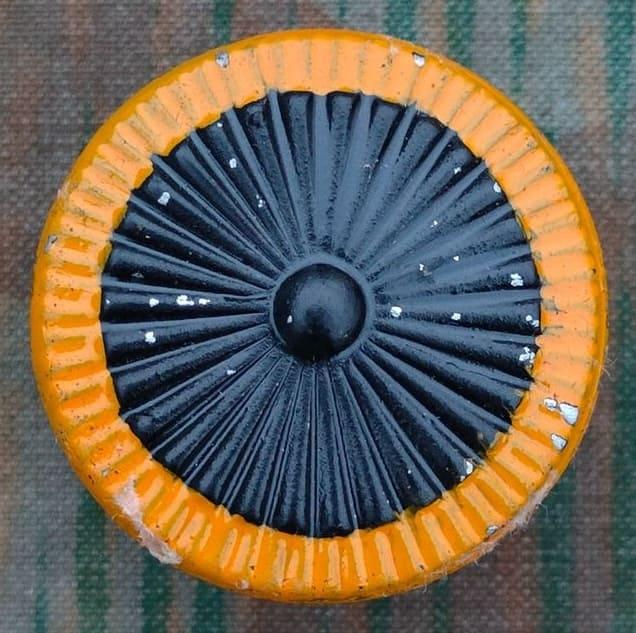 Flagge "Flagge des Kanton Uri" bei fahnenversand.de kaufen.
Flagge "Flagge des Kanton Uri" bei fahnenversand.de kaufen.
 Flagge "Flagge des Kanton Uri" bei fahnenversand.de kaufen.
Flagge "Flagge des Kanton Uri" bei fahnenversand.de kaufen.
Last modified: 2025-03-22 by martin karner
Keywords: switzerland | uri | bull | german |
Links: FOTW homepage |
search |
disclaimer and copyright |
write us |
mirrors
Pascal Gross, 19 June 2001
To illustrate the "liberties taken by the heraldic artists", this
illustration comes from Achermann (1990). Here the bull seems to have eaten a bit more and looks somewhat better this way.
It contrasts with the more commonly seen rather skinny shape of the bull's head,
shown at the top of this page and known on a flag dating from the 15th century.
Pascal Gross, 19 June 2001
The bull's head is called Uristier, meaning aurochs, Bos uris, which
was domesticated by the original settlers. The red ring was originally gold. Uri
citizens have been teased that the the nose ring represents the fact that the
people of Uri had to be tamed. The bull has Celtic origins, representing royalty
and a personification of the deity Cernunnos, who bore stag antlers.
Source: Angst (1992), "A Panoply of
Colours: The Cantonal Banners of Switzerland and the Swiss National Flag"
Phil Nelson, 14 October 1998
The kind of depiction presented in the section "Variant of the Flag" on this page may be
perceived as designed only in 1990, which is not the case. This kind of naturalistic depiction of the
aurochs (Uristier) is already presented in the 1942 flag book from Robert Mader
([mro42], picture), and also in
the 1948 publication from the Federal Chancellery about the Swiss arms and seals
(picture). They continued the tradition of more or less
naturalistic depictions since the Middle Ages. In the second half of the 20th century the image was
simplified towards a more stylized depiction (picture). This
version is also used for the licence plates of vehicles. Around 1990 the newest version was introduced,
which makes a reference to the oldest Uri banners (e.g. to the banner of 1315, see below)
(picture). Since 2012 this version is used for the logo of the
cantonal authorities (picture, source).
Martin Karner, 23 November 2023
– Oldest known seal of Uri, around 1249, head of bull in profile (sign-off) (source).
– Oldest existing banner of Uri, carried in the battle of Morgarten (1315) (source).
– Banner of Uri, carried in the battle of Sempach (1386), with Confederate Cross (source).
– Banner of Urseren valley (15th c., b/w photo). On yellow silk damask a black bear with
red tongue. The cross was originally in silver. Canting with the bear (Latin: ursus) (source: [b7b42]).
– Banner of Uri, carried during the Swabian War (1499) (source: [b7b42]).
– Julius Banner (1512), dedicated from pope Julius II for Uri's
support in the Pavia campaign. Silk damask. Zwickelbild showing Crucifixion scene; below the papal
keys are applied (source).
– Stained glass plate (1639); banner with Resurrection scene in the canton (after banner carried in the battle
of Grandson, 1476); halberdier blowing a horn of an aurochs (German: Auerochse, Ur, "Uristier", the heraldic animal), an old
military instrument. Location: town hall of Sempach LU (source).
![[Colour Flag UR]](../images/c/ch-ur_56.gif) image
by Ole Andersen
image
by Ole Andersen
Simple rectangular cantonal flag, as shown in Kannik (1956) [So-called
colour flag (Farbenfahne in German)].
Ole Andersen, 4 August 2002
See also: STATE COLOURS in Dictionary of Vexillology
Flaggen, Knatterfahnen and Livery Colours |
||
![[Knatterfahnen]](../images/c/ch-ur_kf.gif)
|
||
Flaggen are vertically hoisted from a crossbar in the manner of gonfanon, in ratio of about 2:9, with a swallowtail that indents about 2 units. The chief, or hoist (square part) usually incorporates the design from the coat of arms – not from the flag. The fly part is always divided lengthwise, usually in a bicolour, triband or tricolour pattern (except Schwyz which is monocolour, and Glarus which has four stripes of unequal width). The colours chosen for the fly end are usually the main colours of the coat of arms, but the choice is not always straight forward.
Knatterfahnen are similar to Flaggen, but hoisted from the long side and have no swallow tail. They normally show the national, cantonal or communal flag in their chiefs.
Željko Heimer, 16 July 2000
See also: HANGING FLAG, VERTICALLY HOISTED FLAG, LIVERY COLOURS in Dictionary of Vexillology

 images located by Martin Karner
images located by Martin KarnerAt the beginning of the 20th century, flamed flags were still in use, with the white cross replaced by
a (baroque) shield in the centre of the flag. These decorative flags had been used until WWII and then
somewhat forgotten in preference of the current cantonal flags. [Today they are being
produced again, see right image]
Pascal Gross, 30 June 2002
See also: • National flag and other cantonal flags with "Early 20th century flag design"
• Modern flamed flags
• FLAMMES in Dictionary of Vexillology
logo.jpg) image located by Martin Karner (8 May 2024)
image located by Martin Karner (8 May 2024) image located by Martin Karner
image located by Martin KarnerCockade for the cantonal troops' headgear (regulation from 1898, size: ca. 35 mm, reverse side).
Martin Karner, 14 March 2025
See also: Cockades (Swiss Army)







